Willa Latham, porcelain dealer

English porcelain
‘My grandmother had a house full of antiques, so I sort of inhaled them subconsciously while I was growing up, absorbing the sense of quality and beauty they embodied. I trained as a classical violinist then worked as an accountant in the charity sector.
But, one morning about three and a half years ago, I woke up and announced to my husband: “I’m going to collect antique porcelain”.
‘Although I buy and sell porcelain professionally now too, personally, I only collect tableware by Stoke-on-Trent manufacturer Henry Daniel (1765–1841). It’s always wonderful to find a dusty and unloved piece in an auction, then wash it and reveal its beauty. I have a whole cabinet full of his work and, if I had more space, I’d buy more, but I live in a small flat!
‘He was a genius when it came to colours and painted designs. He came from a family of colour makers who made enamels for the porcelain and china industries. He came up with hues that nobody else was making, such as a stunning jade that you can’t even really describe in words.
He employed really talented painters and the flower decorations on his pieces have a freedom to them that’s very rare to find. He made fine shapes too – his teacup handles perfectly suit my hands.
‘Henry Daniel only made porcelain for 24 years. He worked for Spode as head of decoration before he set up his own factory with his son, Richard, taking most of his painters with him in agreement with Spode, an unusually amicable parting!
It shows how much he was respected and also how large the market was. Richard worked with him (the factory became H&R Daniel) until Henry died. Sadly, the business didn’t last long under Richard’s leadership.
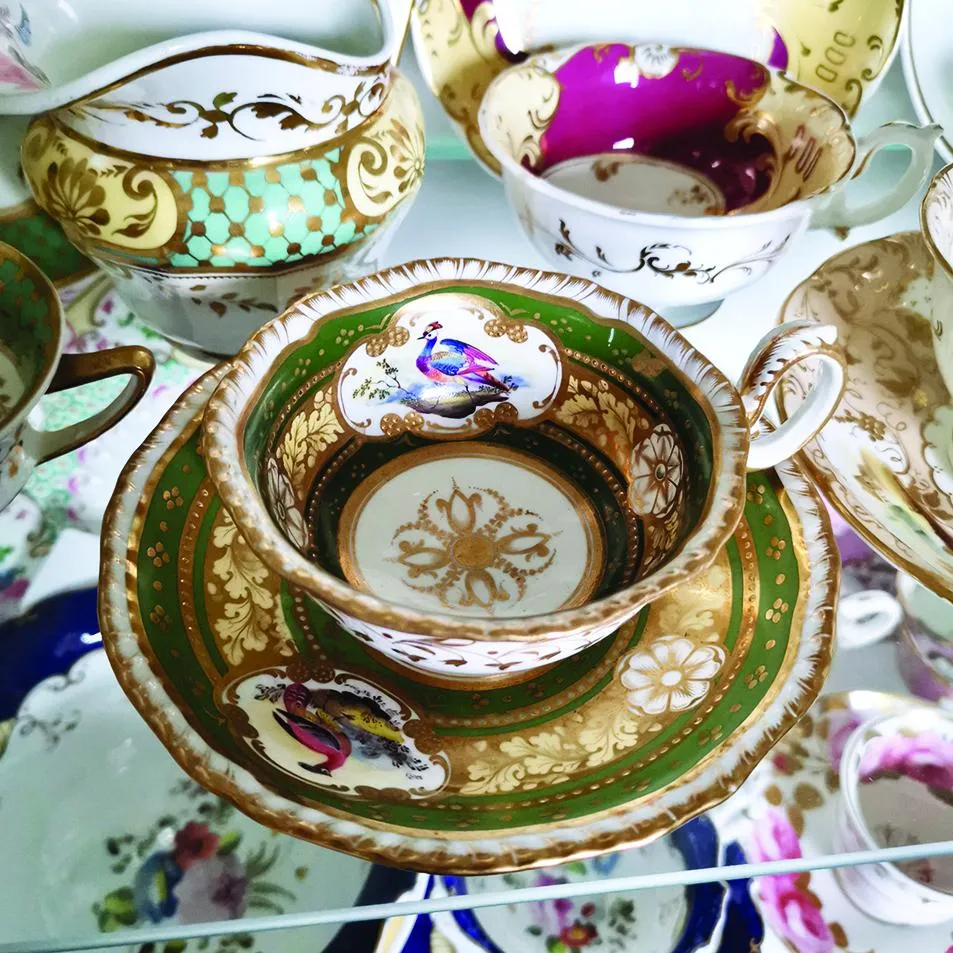
‘My favourite service is kept on the top shelf. It was painted for H&R Daniel by William Pollard – the ‘Van Gogh’ of porcelain painting. He painted flowers with such elegance and his use of colour is so delicate. He didn’t go for big impressive blooms, instead, he chose humble flowers such as dog roses and cornflowers.
‘I love the stories behind each piece. I have a library here. A lot of factories copied each other, accomplished artists often got poached by other firms and most items are not marked, so you need a lot of books if you want to know your stuff.
I use the cups sometimes, but the one thing Daniel wasn’t very good at was the components of porcelain, so it’s very fragile. Luckily, my experience as a musician means I’m used to handling expensive violins, so I’m very careful.’
Visit Willa's website Gentle Rattle of China where she provides bespoke antique porcelain of the finest quality.
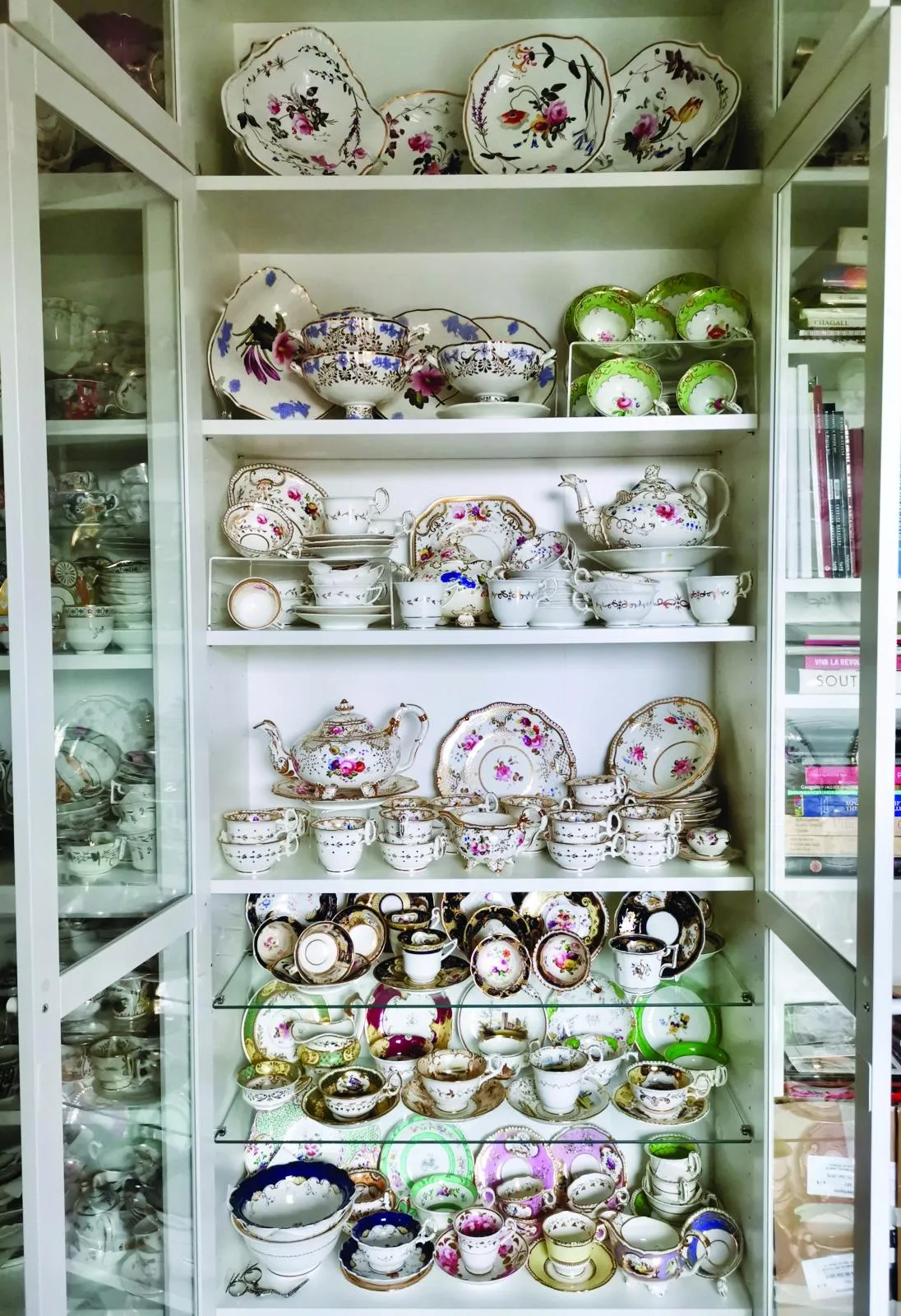
Martin Rowson, cartoonist

Taxidermy
‘Natural history has fascinated me from an early age. I’ve been a member and a fellow of the Zoological Society of London since I was 18 and I’ve been a trustee since I was 33 (I’m now almost 62.)
If I had my way, I’d fill the house with exotic fauna – alive – but it would be rather dangerous, and illegal. So, instead, I like the idea of living in something that looks a bit like a museum.
‘It all started in my late 20s when I bought a mongoose and a cobra (quite a common pose for taxidermists) for £5. I got it as a gag to give to a couple I knew as a visual metaphor for their marriage. But I kept it, then slowly acquired more.
You might also like Luke Honey discusses collecting piscatorial taxidermy
‘I went to the sale of the stock of Eton College Natural History Museum in 1996 and bought a stuffed vulture by mistake because I forgot to take my hand down.
I also bought a piece of basking shark skin, which was given to the museum by Gavin Maxwell, author of Ring of Bright Water. It’s a genuine literary icon – a part of the basking shark that he and his pet otter ate.
‘A friend of mine went to an auction of surplus stock from the Passmore Edwards Museum (which had been closed down) and he got me a wolf for £240. I picked her up in our Volvo Estate and, every time we overtook somebody on the motorway, they nearly crashed.
She’s very useful at Halloween and puts the wind up people who come to read the gas meter. My family says she’s tatty and probably full of beetles, but I could never get rid of her. I love her very much.
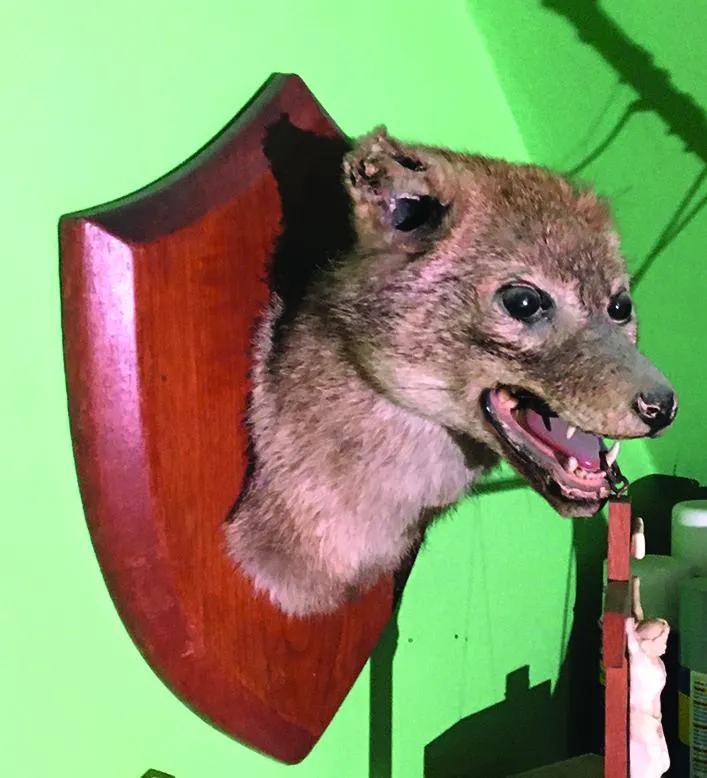
‘My collection is not completist. It’s just made up of things I like. I have a one-eared fox (a cleaner dropped it), a wild boar’s head I found in a junk shop in Normandy for about £5, a mammoth’s tooth and a whale vertebrae, which was given to me by a friend of mine who was a curator at London Zoo.
He also gave me a hyena head that he found in a skip there. I’m a public atheist, so I’ve turned it into a blasphemous tableau – a surrealist installation with the hyena and my school confirmation crucifix. A gull roosts on top of my archive and I have a model of a human skeleton on a deckchair in the back garden.
I have to control myself otherwise I get over-excited. I got close to buying a stuffed American bison on one occasion – he was about 7.5ft tall and 9ft long – but I realised I had nowhere to put him. I was tempted by a rearing African lion once, too, but my wife said: “It’s him or me”.
‘I recognise that it’s slightly creepy having dead creatures around but I didn’t kill them and it’s more insulting to do what people with taxidermy collections were advised to do in the 1990s and burn everything. These creatures have been memorialised and it is respectful to preserve them I think, because they bring joy and they’re educational, too.’
Visit the website of Martin Rowson, multi-award winning cartoonist, illustrator, writer, graphic novelist, broadcaster, ranter and poet.
Louise Allen and Piers Newth, antiques dealers

Garden tools & gardening ephemera
Louise: ‘We’re horticulturalists. I used to work at Oxford Botanic Garden and Piers worked at Harcourt Arboretum, but we both trained at Wisley and that was where we first encountered garden tools that had been used since the 1930s.
They were incredibly well made and that instilled in us a deep appreciation for older tools. As gardeners, we know what a good tool feels like.
You might also like the top arboretums to visit in the UK
‘We always say that old garden tools have had the corners worn off by somebody for you. You can look at a fork or a spade and tell if it was used by a left-handed or a right-handed person by the way that the blade or the tines have worn.
They tell you a story. I often admire a tool and wonder: who used this? Garden tools carry their history with them – they’re very personal.
‘The first item we ever bought was a collection of 1950s French seed packets in a little shop in The Lanes in Brighton. The colours were exquisite – they were so beautiful and it seemed incredible that they had survived.
I love ephemera. It always excites me. In the past, things were made to last. Suttons seed tins from 1910 in our collection were sometimes sent out to India, then found their way back to Britain.
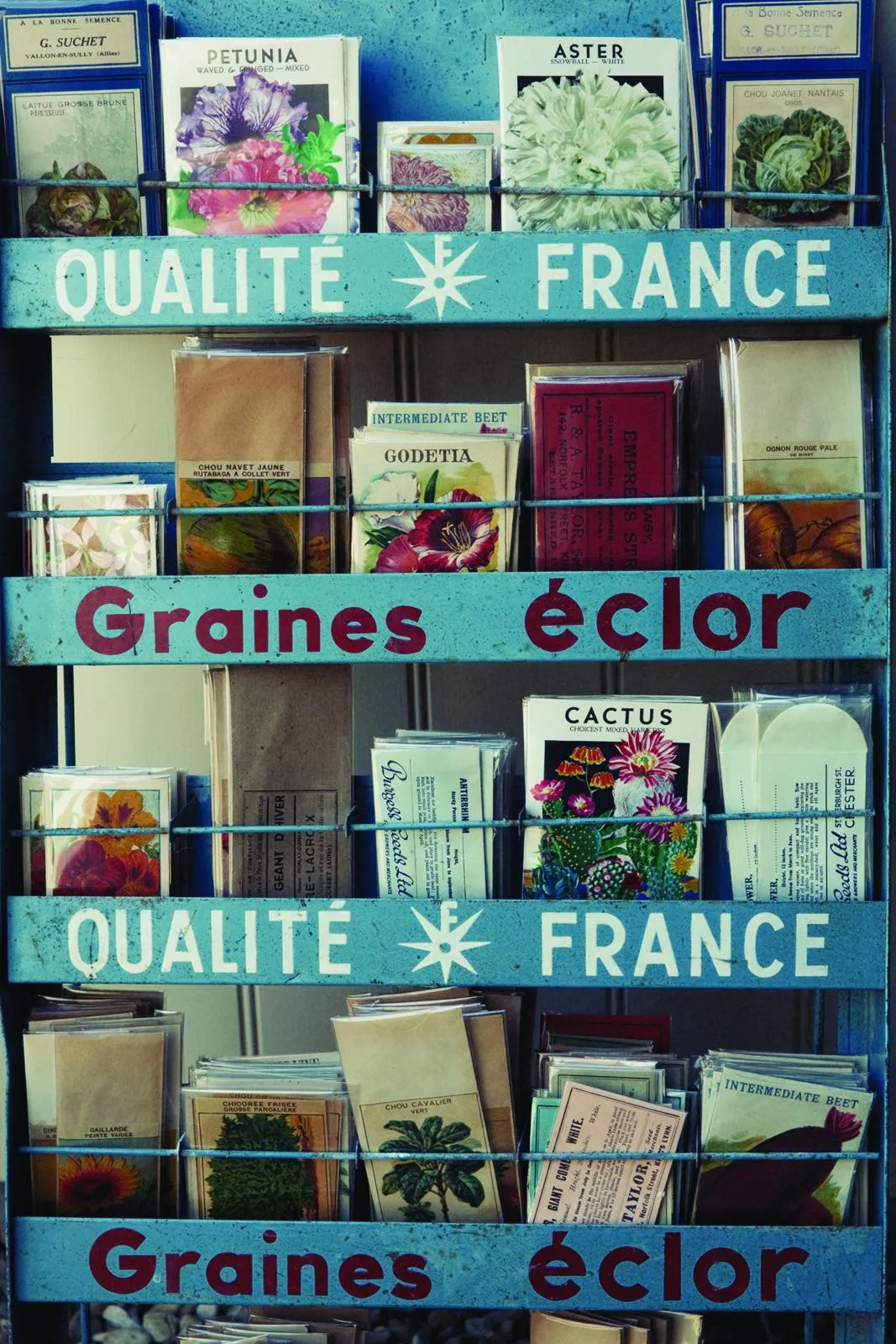
‘Over the years, we’ve gradually accumulated more and more ephemera and tools. Our collection is always evolving, but there are some core things that we will never part with. Piers has a spade, which I once dared to pick up – that was a mistake. You can’t use Piers’ spade!
You might also like where to buy garden antiques
Similarly, I have a Victorian fern trowel that I love. It has a beautiful long, thin blade. It’s incredibly collectable because not many of them were made and it’s formidable in the garden for getting weeds out. We have inherited Piers’ grandfather’s garden line, which we will always treasure as it has sentimental value but, also, it’s the perfect tool for the job.’

Piers: ‘Wherever we go, we’re always on the lookout for something. We never stop. Auctions and antiques fairs are the best places to source tools. The internet is amazing, but nothing beats the thrill of the chase and actually holding items in your own hands.
‘The exciting part is not knowing what a tool is, then working out what it’s for. We recently acquired a Victorian ebony-handled pot rake but we had no idea what it was when we got it. It embodies the art of gardening – the idea of utter perfection.
You might also like decorating with garden antiques
‘The real joy of collecting is the enormous diversity. The world of gardening is huge and Britain made some of the best gardening tools in the world, so there’s a sense of pride that many of the best tools started life here.’
Visit Louise Allen and Piers Newth website Garden and Wood where they specialize in antique garden tools, furniture and ephemera.
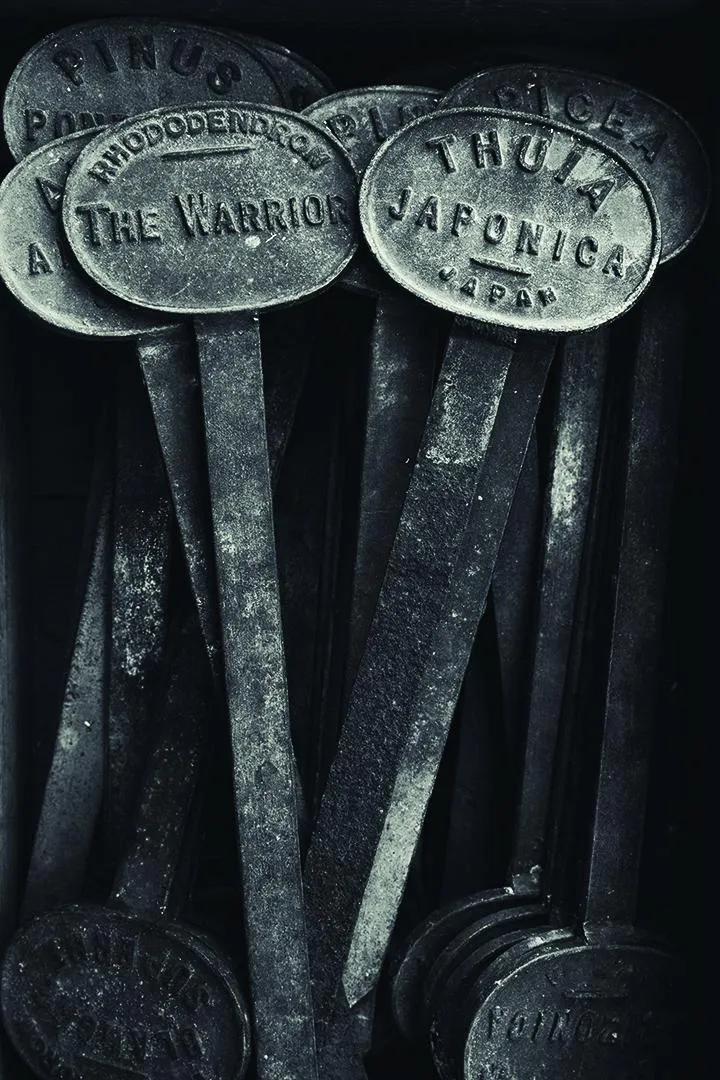
Elizabeth Reese, microbiologist

Typewriters
‘I’ve always been a collector. As a child, I gathered seashells and fossilised sharks’ teeth in jars. My parents took me to antiques markets, so I grew up around old things and I’ve always been into analogue stuff – I’m a girl out of time.
I still shoot film photography and have a stash of old cameras because I like to feel what I’m doing. It’s the same with typewriters. Typing is very tactile and the sounds are great. You watch your words come to life with the action of the keys.
‘My first typewriter was a gift from my father in 2010 – he bought it on eBay for me. It’s a 1928 Corona 4 typewriter in fire-engine red. Most early ones are black, so this is a rare early example of a coloured model.
Between the 1940s and 1960s, lots of manufacturers brought in vibrant, pretty models as a marketing gimmick to attract new customers. Once I realised that there were typewriters out there in a rainbow of colours I was hooked.
‘I have 15 now, mostly portable ones. I’m quite selective. My husband and I live in a small house, so that’s another reason to go for portables – they’re slim, they have cases with handles and they stack well.
I have a few on display in a cabinet and the rest are tucked away inside a bookcase. I have one big non-portable model, a giant Royal desk model. It’s so heavy, but I had to have it because it’s pink!
‘In 2015, typewriters were really popular and prices shot up briefly, but they’re more affordable again now. Today, a good machine in working condition can cost anything from a few hundred pounds up to £1,000 depending on how rare it is and the colour.
I can live with a few dents or scratches, so I get some bargains, but some collectors want everything to be perfect. Impeccable models are the most expensive.
‘I was lucky enough to be given a Groma Kolibri typewriter from a relative of my husband. It’s a hard one to find. They’re made in Germany and it’s very sleek – if Apple made a typewriter, it would be this one! It’s so streamlined.
There are a few models still on my wishlist. I’m always on the hunt for a Royal Quiet De Luxe in ‘Aqua’. There are boring grey and black versions that are more common than the coloured ones. They come in a distinctive houndstooth patterned case, so I’m always on the lookout in charity shops.
Until you open the case, you can’t tell whether it’s coloured or not. They fetch huge sums on eBay. I’d also love a Vogue typeface typewriter. They’re difficult to find because not many were made.

‘My typewriters aren’t just for decoration, I use them to write letters and postcards. When I started my vintage Etsy shop I typed out labels and business cards on them, too.
I have an Olympia model that has a pretty cursive typeface on it – it’s one of my favourites to type on. I named my Etsy shop (The Rusty Typewriter) after a rusty blue Smith Corona typewriter that I bought for next to nothing at a flea market.
‘I’m a compulsive collector. I have a lot of vintage cameras, a huge stash of McCoy pottery and lots of old books, too. I like to give new life to old things instead of buying something new.’
Caroline Tremlett, business development consultant

Jelly moulds
‘I’ve been collecting jelly moulds for 15 years and I’ve got about 60 now. I just can’t resist them. Look at them – what’s not to love?
My ceramic ones live on a shelf in the living room and my copper ones are displayed in the kitchen. I’ve also got quite a few hidden away in cupboards – I don’t think my husband quite knows how many I’ve got!
‘The first mould I bought was an Ironstone 1920s Shelley ‘Star’ one. Shelley was one of the first firms to be able to show the pattern on the outside as well as the interior of the mould.
You might also like how to decorate with antique jelly moulds
‘Older moulds tend to have plain exteriors with no definition. I’ve got the Shelley ‘Queen’ mould, too and I was given the Shelley ‘Swan’ for Christmas.
‘My favourite shop is Appleby Antiques – it’s a treasure trove. I bought one of my favourite ceramic moulds from there: a fish with scales which leave a beautiful pattern on the jelly.
‘It’s hard to choose favourites but I have a Wedgwood one that has a gorgeous lily and morning glory design. The Copeland ‘Lion’ mould is a recent acquisition and I’ve got a lovely Grimwades ‘Bunny’ mould, too, which is beautiful.

‘Lots of moulds weren’t marked, so you don’t always know who the maker was, which is very annoying. I have a Benham & Froud one which has the brand’s trademark cross on it and a marked Trottier one from Paris, but the rest don’t have makers’ marks.
Some have model numbers and initials though – the initials are of the original owner, so that when jelly moulds were taken to be re-tinned, they were returned to the right household afterwards. Initials can add a lot of value to a mould if it’s a recognisable name. For example, ‘D.W.L’ stands for ‘Duke of Wellington, London’.
‘Jelly moulds with liners (which create amazing jelly-within-jelly effects) such as the 1864 Brunswick Star or the 1863 Alexandra Cross are a thing of wonder, but they’re very rare and very expensive. If you do find one, it’s often missing the liner. People are making versions using 3D-printers today, which is exciting.
‘I didn’t actually use any of my moulds until recently but, last year,I decided to set myself the challenge of making a jelly every day using my antique moulds and post all my creations on Instagram.
There are lots of people who want to see the ‘wobble’ so ‘slo-mo’ videos of my jellies have really taken off! I went on the most amazing jelly-making course back in 2008 with food historian Ivan Day, which really inspired me and I’m working on a book called The Jelly Diaries to chronicle my journey.
‘I’ve used milk, wine, hot chocolate, fruit juice and shop-bought jelly cubes. I would love to time-travel and eat at an elegant banquet. Inspired by the Georgians’ ornamental jellies, I’ve experimented with putting cockle and whelk shells, holly berries, ivy and even flowers inside my jellies recently.’
Anthony Moss, founding member & joint Chairman of The Antique Cane Society

Walking canes
Collecting has always been my craving, starting at the tender age of nine, collecting books. Coming from an inherently poor family, we had little in the way of personal possessions, so when my wife Deanna and I got married 57 years ago, we bought Victorian furniture as it was cheap. In the 1970s, our appetite expanded to encompass a wide range of antiques and collectables.
In 1998 Deanna made the mistake of buying me a few walking canes, and thus my passion as a ‘Rabologist’ – a collector or student of walking sticks – began. Collecting is like controlled hoarding; to some degree an obsession and illness. The thrill is the discovery, and as I wander around an antiques fair my eyes are trained to only see walking canes. I am not driven by buying only the best, but by finding a rare example and a missing specimen to add to the 2,600-plus pieces in my collection.
It is worth pointing out the difference between a cane and a stick – one carries a cane and walks with a stick. Nowadays, collectors and dealers approach me with offers or unusual finds – I’m in touch with a network of dealers in the UK, US, Netherlands, Germany, Belgium, France and Italy. Deanna and I have fond memories of attending fairs such as Olympia Art & Antiques Fair and Battersea Decorative Antiques & Textiles Fair, both still running today. Online auctioneers like Hannam’s, Burstow & Hewett and Sworders – and eBay – are all good sources.

Sometimes it’s challenging to refuse a good piece, especially if it has some exciting provenance or is exceptionally rare. My wife banned me from filling the house with walking canes, so I have a few choice pieces on display around our house in stick stands!
A standout piece is a silver-handled Art Deco cane, commemorating the dirigible airship Norge making the first-ever crewed flight over the Arctic ice cap from Europe to North America. A dynamic design made of silver, it has the maker’s mark and initials of famous French jeweller Gustave Keller. I find it incredible how much history is bound up in these wonderful objects.
Completely obsessed with the subject, I have written a book called A Visual History of Walking Sticks and Canes, which includes pieces from my collection, and details on everything from cane classifications to handle motifs. My advice for a young collector would be to buy quality, not quantity – a collection of 15 excellent walking canes is far better than a collection of rubbish.’
Laura Hunter, ‘chintzfluencer’

Staffordshire figures
I first acquired a piece of Staffordshire pottery around four years ago at an antiques show in Henley. I was attracted to the bright colours – at the time we lived in a modern house, and I liked the juxtaposition of it amongst all the minimalism. I’m very attracted to ‘chintzy’ items, like pottery figures or embroidery. I also collect crochet doilies, which I use under vases, coasters and candles. My grandparents were big fans of a ‘knick-knack’, so I’m guessing it’s a genetic thing.
I collect mainly figures of people, and some cows, but I’m not so keen on the dogs. What’s great about these figures is that they are readily available in most charity shops as well as antiques shops and fairs – Lamb Arcade in Wallingford, Oxfordshire, has become my favourite hunting ground.
Whenever I visit a new town, I generally come back with something – they serve as nice mementos of the places I visit. People have also started buying them for me as gifts, which is rather nice. They have a real sense of nostalgia for people and the most common comment I hear is, ‘My grandma used to collect these!’

I usually display figures on bookshelves where they can be seen; in the living room I have around 10 figures on our TV cabinet. I also have a few on bookshelves in my study. We are currently renovating, so quite a chunk of my collection is stored away, but as and when a room is finished, I pop a couple out on shelves. On my Instagram account @nofeaturewalls I mainly focus on interiors and fashion, but the figures occasionally make an appearance.
My favourite item is a group figure of two gentlemen, bought from an antiques shop in north Oxfordshire. It’s in really good condition and the colours are still so bright; I just love it. I usually pay £40–£100 for a piece, but my best bargain to date was a flat-back cow and milkmaid set that I got at a Sue Ryder shop for £1!’
You might also like how to buy and collect Staffordshire dog figurines
Pom Harrington, owner of Peter Harrington

Roald Dahl books
Peter Harrington, one of the world’s leading rare book dealers, was founded by my father, so I am the second generation to work in the rare book business. I love collecting books – it’s not just work, it’s also my hobby. I started collecting Roald Dahl when I was around 21, after my father gave me an inscribed first edition of The Wonderful Story of Henry Sugar for Christmas.
In the beginning, I didn’t have a big budget so I’d visit smaller book fairs and pick up first editions when I came across them. The first Dahl book I bought was a first edition of Kiss Kiss for £30–£40. I collect UK and US editions of all his books, and most are inscribed.
There is an element of nostalgia linked to collecting in any form. Most people collect something that connects them to their childhood, significant episodes in their life, or things they love. I strive to make my collection the best it can be, so if I ever find better copies of any titles, I swap them out. It’s fun upgrading books in my collection; it is something that can keep going for as long as I want it to.

I currently have around 100 pieces. Some of my favourites deal with significant ‘firsts’ in Dahl’s career. The first is a copy of Fantasia, which is a Disney animated film, inscribed by Walt Disney to Roald Dahl. Walt Disney gave Dahl his first real break: his first book, The Gremlins, was published by Walt Disney Company in 1943.
Another favourite is a first US edition of The Gremlins – it couldn’t be more poignant as it is inscribed by Dahl to his mother, who he shared a very close relationship with. Many of Dahl’s books were first published in the US, where he lived for much of his life, as his wife was American. Early UK editions signed by Dahl are hard to find.
The search is never-ending, and I am on the hunt for an inscribed UK edition of The Gremlins. I am also missing a UK first edition of James and the Giant Peach and a US edition of The Witches. I believe my collection will one day be complete and I suspect I will sell it, but I am nowhere near that point yet.’
Jennifer Bristow-Smith, textile dealer

Mother-of-Pearl buttons
I remember being fascinated by the jars of old buttons my grandmother had collected for repairing clothes, and I spent hours sorting through them as a child. My own collection didn’t start until more recently though, when I began my antique textile business, Starched and Crumpled – even then, it wasn’t a deliberate decision. It was something that happened in the margins of going to markets and auctions and seeking out stock for my business. I would often find myself buying Victorian buttons to replace those missing on antique clothing and, before I knew it, I had amassed quite a collection!
I have many jars of buttons displayed on the shelves of my studio in Scotland. I love how buttons are both useful and decorative. I have several thousand, all in different shapes, sizes, colours, and materials, but the ones I like best and purposefully collect are 19th-century, intricately carved, mother-of-pearl buttons. These are the ones that go into a special box whenever I find them, and I won’t part with them.
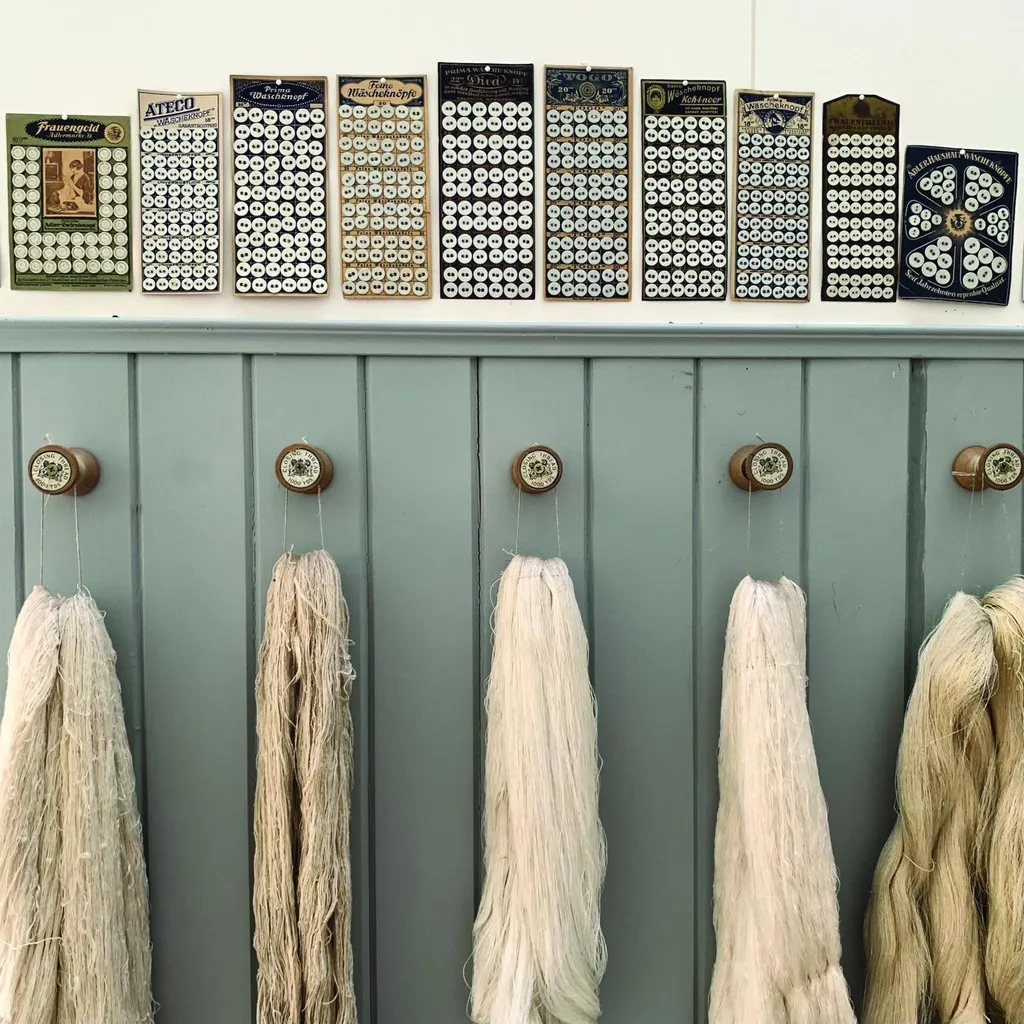
It’s difficult to say where or how I collect, because I rarely go looking for them; they just seem to turn up in all sorts of places, from West Country auctions and second-hand shops in Scotland, to eBay and antiques markets in France. There is definitely a bit of magic involved in finding buttons, and I have come to believe that the less you look, the more you find!
Some 20 years ago, when I was living in Norway, a friend and I travelled together to London and visited Portobello Market in search of antique fabric. I remember finding a wonderful shop full of antique buttons and, to my surprise, my friend ran away in distress. I couldn’t understand it, but have since discovered that having a fear, or phobia, of buttons is a very real problem – it’s called ‘Koumpounophobia’.
An enormous pleasure for me was when my five-year-old granddaughter started sorting through some of the jars in my studio and picking out the buttons she liked best – she chose the rarest and most sought-after. At five years old, the girl already has good taste! I love how this appreciation has gone full circle, from me sorting through my grandmother’s buttons to my granddaughter sorting through mine.’
You might also like the history of antique mother of pearl
Erika Stefanutti, artist and craftsperson

Tartanware
I’ve been a collector for as long as I can remember. Among my first collections were small pebbles and acorns picked up outside, empty perfume bottles and small glass animal figurines purchased on family holidays. Then came stamps, dolls’ house miniatures and furniture, found feathers and birds’ eggs, fossils, books, postcards and beads. I could go on.
Objects hold a great deal of romance for me, and so I’m still on the hunt for interesting things to ponder. I’m lucky in that my family travelled to South America and Europe quite often when I was a child, and so I was exposed to the particular aesthetics and crafts of these places from an early age. This must have had a significant influence on me, as I produce handmade desk furnishings and decorative objects – all made by hand – from my studio, Parvum Opus.
Today, I am a collector of many things including books, ex libris bookplates, antique engravings, modern paintings and works on paper. Also, Grand Tour plaster intaglios, pietra dura paperweights, antique desk accessories and pen wipers, watch fobs, desk seals, antique diatom microscope slides and biscuit barrels. I even collect magnifying glasses, Imari porcelain and blue-and-white Canton export plates, and minerals and fossils.

When it comes to tartanware, I have 65-plus pieces in my collection, so far. I don’t have a particular favourite, but I particularly love the tiny tape measure, a round ruler with a secret matching tartan pencil and eraser inside, and a jotter with a gold-tooled leather spine that is full of notes about several ‘voyages à Paris’, c1850. I can only imagine, since the notes are all in French, that the owner either travelled to England and Scotland herself and selected this piece as a souvenir, or was given this piece by a special friend.
A good number of my tartanware pieces are displayed together on a shelf in our library, but I have several pieces that I put to use like the string holder, letter sorters and rulers – I like the idea that these collected pieces can be useful in a new century.
I don’t plan on selling any pieces from my collection, as they are sources of inspiration and fascination for me. I do occasionally, however, share images of these pieces on my Instagram account @parvumopus and the feedback is always very positive. People just love tartanware, I imagine for the same reasons as I do: the infinite variety of forms, the intimate scale, the functionality, the craftsmanship and patina and, of course, the wonderful patterns. I’m never on the hunt for any specific pieces but, should a piece cross my path, I’ll always find it difficult to resist!’ parvumopus.com
